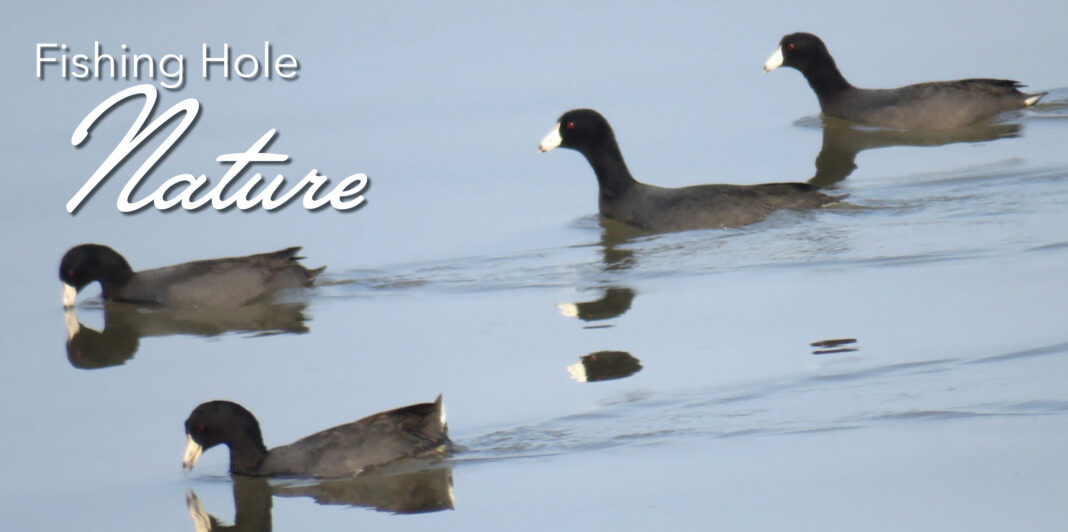Fishing Hole Nature: Mean as an Old Coot
Coots, also known as mud hens, have fierce red eyes, black heads, dark gray feathered bodies, a hint of white wing edges, and bright white beaks. Have you ever heard someone say that your grandpa is “bald as an old coot”? As a coot gets older, a bright white boney shield expands up from its beak to its forehead making the bird look bald. This white frontal shield indicates maturity and fighting ability, and the older they get the balder they look. Hence the saying is “bald as an old coot”.

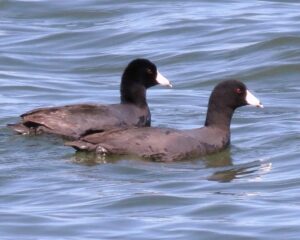
The American Coot live in wetland marshy areas, and mostly eats aquatic plants, insects, and small crustaceans. Much like ducks they swim along, dabble in the water, dive a little, and will also forage on land. Because of this people think that coots are related to ducks, but they are only distant relatives and do not belong to the same scientific order. Coots don’t quack and don’t have big webbed feet. Instead they have scaly long-toed claws which they use to fight. More importantly coots and ducks raise their chicks in very different ways.
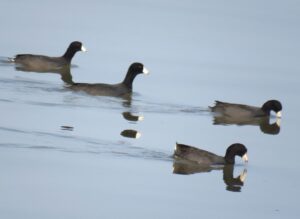
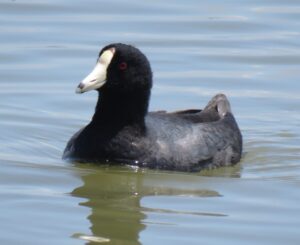
There is another phrase…”mean as a coot”. Weighing in at only one to two pounds, these fierce red-eyed birds display plenty of aggression! They are antagonistic and belligerent, and as parents they are brutal. A wayward female will lay eggs in other females’ nests, hoping that another coot will raise her chicks. But that won’t happen. After a parasitic coot chick hatches, the nesting adults will kill it, sometime by starvation, violent shaking, or drowning. Sadly, the brood reduction usually does not stop there and new studies indicate that only 50% of all coot chicks survive. Coots have large broods, up to a dozen or so, and all chicks have ornamental head feathers of orange and red. It’s been noted that parents favor their brighter colored chicks with the most food, leaving the rest to starve. But it’s also been observed that birth order counts highly toward chick survival. If parents decide to raise only one or two chicks, they will choose the older ones, then harshly starve or throttle the rest. And yet occasionally some coot parents are willing to raise most of their chicks! In short, coot family behavior is hard to understand. Scientists believe limited food resources may play a part in a coot’s choice to kill off its offspring, or perhaps some coots simply don’t have strong instincts to raise their broods. Whatever the reasons, coots are violent birds. The tendencies bred into them are brutal, and the prospects of surviving one’s own parents are bleak. Now you understand the phrase “mean as a coot”.
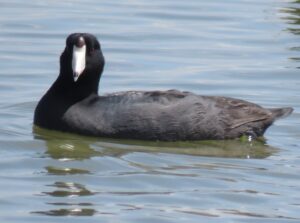
Coots are protected by the Migratory Bird Treaty Act, which makes it illegal for people to harass, possess or harm them, or their nests and eggs.
Learn more about the incredible nature in our area by joining a chapter of the Texas Master Naturalist organization. To find a chapter close to you, or to read about the state program, go online to https://txmn.tamu.edu. Volunteer and get involved!
PHOTOS BELOW
- The American Coot, also known as a mud hen, is only distantly related to the duck family. Coots have long toes with large scales, but no webbed feet
- Coots have black heads, dark grey bodies, white beaks and fierce red eyes. “Mean as an old coot” is a well known saying because these birds are often aggressive and cruel, killing many of their own chicks.
- As a coot ages, it grows a white boney beak extension up its forehead. Hence the phrase, “bald as an old coot”! But this large white shield is a sign of maturity, dominance and fighting abilities.
- Coots can be found swimming and dabbling in calm water near the banks of ponds, lakes, wetland marshes and rivers.
- A red-eyed fierce looking coot.


